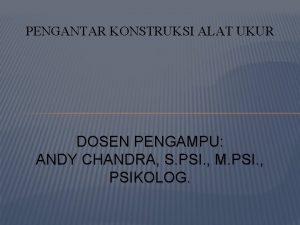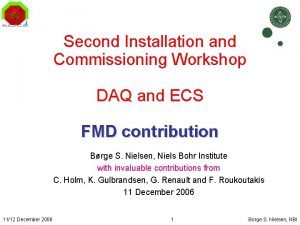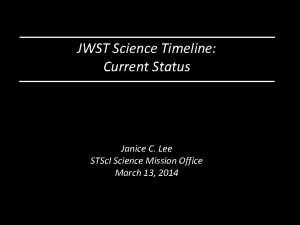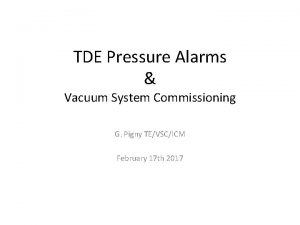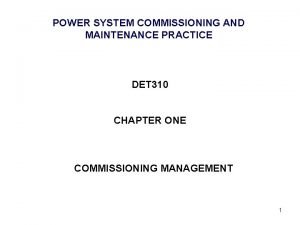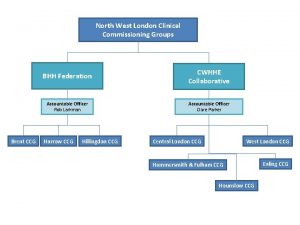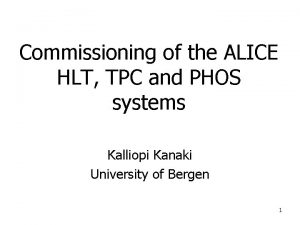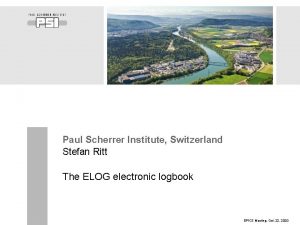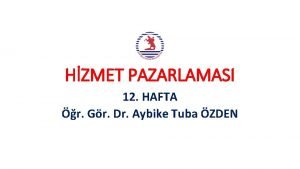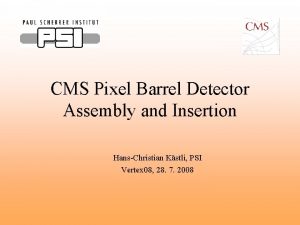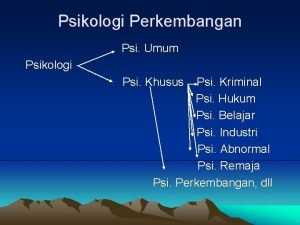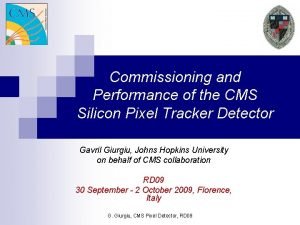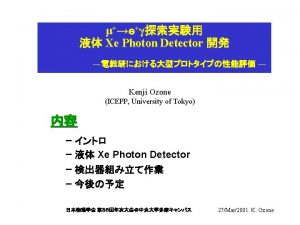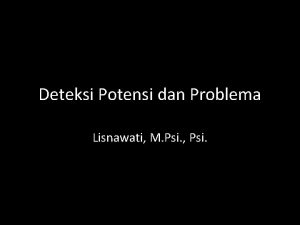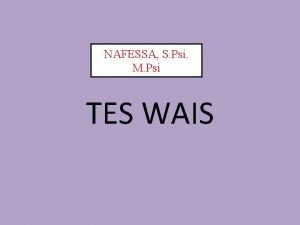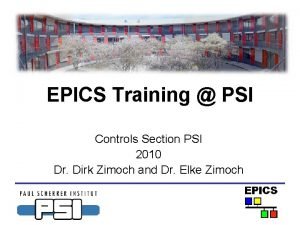CMS Commissioning and Performance HansChristian Kstli PSI 1







































- Slides: 39

CMS Commissioning and Performance Hans-Christian Kästli, PSI 1. September 2010

Swiss CMS Members ETH PSI (mostly ECAL) Physicists: 22 Students: 10 (mostly Tracker ) 3 Uni ZH ( Tracker) 10 10 4 4 3 2 Engineers & Technicians: 11 Total 42 Physicists, 21 Students, 16 Eng. /Techn.

Outline • • • Brief detector overview Appetizer Performance summary Some more details Even more details on selected topics in commissioning and calibration (only for sub-systems with substantial Swiss contributions: ECAL and Tracker)


Sub-detectors operational status

LHC Luminosity as of last week LHC machine progresses extremely well CMS efficiency for data taking is good and increasing (last week 93%)

Appetizer: Dimuon mass spectrum

Appetizer: Dimuon mass spectrum At design value !

Performance

Jets and Missing ET The highest mass dijet event in the first 120 nb-1 of data

Jet Measurement Performance Estimation of jet p. T resolution from data. Measuring energy imbalance in dijet events Left: energy from calorimeters only, right: particle flow techniques applied Better performance than design goal of 100%/Sqrt(E)+5%!

Missing ET Measurement Performance Missing ET measurement in Dijet events with calorimeters alone (left) and with particle flow algorithms (right) Data is very well described by MC over large energy range without tuning! Missing ET Gaussian core resolution: < 10 Ge. V on whole missing ET range up to 350 Ge. V. Factor 2 improvement with Particle Flow technique.

Tracking and B-tagging

Impact Parameter Resolutions Good agreement between resolutions in DATA and MC for a wide range of track p. T and eta (IPtrans)=25 m for central high p. T tracks 14

Impact Parameter Resolutions The 18 peaks in the resolution correspond to the 18 cooling pipes on the innermost detecting layer of the pixel system. Sin modulation due to the displacement of the luminous region w. r. t. the center of CMS Tracker. p. T=1 Ge. V tracks p. T=3 Ge. V tracks --> This motivates an early low mass upgrade of the pixel detector (see Rolands talk tomorrow) 15

Tracking Efficiency for muons (from J/ ) Probe muon Tag muon J/ Is the track reconstructed? Probes passing the matching Probes failing the matching Tracker Muon system Reconstruction efficiency in the Tracker is estimated from the ratio of the yields of probes that either pass or fail the matching with a Tracker track. Measured tracking efficiency close to 99% 16 and compatible with simulation

Pion reconstruction efficiency from D 0 decays Ratio of yields of D 0 --> K 3 and D 0 -> K corrected by tracking efficiency: 17

B-Tagging algorithms Track Counting Algorithm SSV Algorithm tags jets containing N tracks with Impact Parameter (IP) significance exceeding S tags jets according to the 3 D flight distance significance of the reconstructed secondary vertex High Purity configuration: N=3 High Purity configuration: Vertices with 3 or more tracks Jet Probability Algorithm tags jets according to the probability of all the tracks in the jet to originate from the primary vertex, given their IP significances 18

Main Observables used by B-tagging algorithms Signed decay length of secondary vertexes Signs of Impact parameter and of vertex decay length are defined according to jet direction Signed impact parameter of tracks in the jet 19

Data/MC comparison for B-Tagging observables DATA/MC ratio is close to 1 for all observables (including those not shown) 20

A (somewhat) closer look

Detailed understanding of detector performance Momentum resolution vs p. T with 2 -leg muons. Distance of minimal approach with split tracks. Excellent control of the momentum scale. Good understanding of alignment and magnetic field; good description of the detector. Most of the tracker aligned at what was expected after 10 pb-1 of collision data. Performance not too far from ideal.

Study of the tracker material |z|<26 cm A complex activity is ongoing using many different, complementary methods: conversions, nuclear interactions, multiple scattering. Check of the energy loss and of the momentum scale using low mass resonances. Material uncertainty today better than 10% Systematics uncertainties on physics quantities related to material budget <1%.

Low mass resonances • Tracks displaced from primary vertex (d 3 D > 3σ) • Common displaced vertex (L 3 D > 10σ) PDG Mass: 1672. 43 ± 0. 29 Ω- ΛK- Invariant mass distribution for different combinations (Ω± ΛK± or ± Λ ± ) fit to a common vertex. PDG Mass: 1321. 71 ± 0. 07 - Λ -

Primary Vertex Position Resolution Single vertex reconstructed using “all” the tracks Same collision point reconstructed twice using half of the tracks The position of one vertex is compared to the position of the other. Repeating for many events, the intrinsic resolution of the primary vertex fitter is estimated directly from data. 25

Primary Vertex Reconstruction Efficiency Same technique also used to estimate, from DATA, the PV reconstruction efficiency. Tag Vertex Is there a probe vertex ? PV efficiency = #probes / #tags 26

The Pixel Detector: Status >98% of pixels are on and working Barrel: 98. 8% • bad wirebonds for readout or bias voltage • most present at installation time • very few recoverable problems • Endcap: 96. 4% • 5 panels with common symptom slow analog output (share AOH) • developed over time, but monotonic • panel with excessive noise - likely from dirty fiber connection • panel with 1 bad ROC can be recovered with software change “Fast” extraction of pixel detector possible • Repairs made to FPix in Early 2009 • Planning for opportunity in 2012 with LHC shutdown • sufficient spare parts on hand for replacement and repair

Calibration of 66 M channels! Analog pulse height calibration • With internal calibrate pulses (Vcal) • Non-linear for high signals (around 1. 5 -2 MIPs)) • Determine gain and pedestal • ROC average gain known from x-ray tests and MIPs • Q(e-)=65. 5*Vcal - 414 • Using tanh for more detailed studies Threshold calibration With internal calibrate signal Absolute thresholds: Barrel: 2. 4 ke. Endcaps: 2. 5 ke. In-time threshold around 750 ehigher

Pixel cluster charge Cluster charge for hits on tracks (pt>2 Ge. V/c) Remarkable agreement between 7 Te. V collision data and MC • Even the tails are ok • Peak position correct to 2% (barrel) or 4% (endcaps) • Widths slightly larger in data: 10% (barrel) and 15% (endcap)

Large beam background events Energy dependence of hit multiplicity Hit map of one event. Area corresponds to about 2 modules Occasional problems observed at high rates of large events (event synchronisation lost). Firmware modification was needed.

CMS Calorimeters Electromagnetic calorimeter, ECAL: Homogeneous Pb. WO 4 crystal calorimeter • Barrel (EB): 26 X 0, ΔηxΔφ = 0. 0174 x 0. 0174 • Endcap (EE): 25 X 0, ΔηxΔφ =0. 021 x 0. 021~0. 050 x 0. 050 • Preshower in endcap (ES): 3 X 0 lead with 2 planes of 61 mm x 1. 9 mm Si strips Target resolution: 0. 5% at high energy > 99% working channels (EB: 99. 3, EE: 98. 94, ES: 99. 8) stable conditions: temp. RMS 0. 003 o. C (EE: 0. 015 o. C). Laser response stability < 0. 02%. Hadronic calorimeter, HCAL: • Barrel (HB): Brass + Scintillators • ΔηxΔφ = 0. 087 x 0. 087 • Barrel tail catcher (HO): Scintillators • Endcap (HE): Brass + Scintillators • ΔηxΔφ = 0. 087 x 0. 087. . . 0. 35 x 0. 087 • Forward (HF): Steel + quartz fibre (Čerenkov) • ΔηxΔφ = 0. 349 x(0. 175 or 0. 35) > 99. 75% working channels (100% in HB/HE/HF)

ECAL clusters (electrons and photons) 1 Ge. V 4. 5 Ge. V timing resolution distribution energy distribution

Calibration Synchronization All channels synchronized. Providing a time measurement precision better than 1 ns. Calibration Start-up calibration uses results from a 10 year campaign of test-beam and cosmics rays precalibation, in-situ “splash” events and 0 calibration. Precision of start-up calibration: EB: 0. 5% ~ 2. 2% (1. 2% in central region with first 120 nb-1) EE: 5% ES: 2. 2% (better than design goal) In-situ inter-calibration with -> events Target with 10 pb-1: 0. 5% in EB; 1%~2% in EE

Progress in MET Excellent resolution and small non-gaussian tails. Understanding all sources of erratic noise is very important for cleaning the distributions. MET ready for physics.

Anomalous Signals in Calorimeters In collision data we observe some anomalous signals in ECAL and HCAL Now reproduced in simulation. ECAL HCAL: HB, HE HCAL: HF 2004 Test beam Fiber Bundles PMT Window Appear mostly in a single crystal In time with collisions but with wider time-spread (also occur in cosmics at a much lower rate) Caused mostly by deposits in APDs by highly ionising secondary particles. Appear in 1 -72 channels Random, low rate, ~ 10 -20 Hz (E>20 Ge. V) Caused by ion feedback, noise & discharges in HPDs Appear mostly in one ch. In time with collisions Caused by Cv light by particles going through PMT glass

Conclusion CMS is in good shape and deliveres excellent data quality All sub-systems have >98% of the channels on Understanding of detector is mostly very good In some cases performance is already better than the design goal A big thank you to the LHC machine group for the great performance

Backup Slides

Pixel hit resolution Using overlapping module pairs With > 30 shared tracks Double difference is sensitive to resolution but insensitive to • alignment • multiple scattering • track extrapolation 2009 LHC min-bias data Barrel Modules (local coordinates) All No double-wide pix σx=12. 8± 0. 9 μm or 12. 7± 2. 3 μm σy=32. 4± 1. 4 μm or 28. 2± 1. 9 μm Compares well to detailed Simulation (PIXELAV) σx=14. 1± 0. 5 μm (no double-wide pix) σy=24. 1± 0. 5 μm

Lorentz Angle Barrel: & & cot α= -0. 462± 0. 003 (PIXELAV simulation: -0. 452± 0. 002) Forward: & cot α= -0. 074± 0. 005 (PIXELAV simulation: -0. 074± 0. 004) Cluster Size Method At minimum cluster size: & α=θL + 90° Measured with cosmic rays for B=0 and 3. 8 T 2008 T=14° C 2009 T=4° C
 Andy chandra s.psi m.psi
Andy chandra s.psi m.psi Integrated commissioning and progress system
Integrated commissioning and progress system Commissioning cycle
Commissioning cycle Aecp army
Aecp army Steps
Steps Ecs commissioning
Ecs commissioning Heat pump balance point
Heat pump balance point Timeline jwst
Timeline jwst Hmsweb.hms
Hmsweb.hms C3sc
C3sc Value based commissioning
Value based commissioning Vacuum systems commissioning
Vacuum systems commissioning Power system commissioning
Power system commissioning Nihr central commissioning facility
Nihr central commissioning facility Dominik sikora
Dominik sikora North west london ccg
North west london ccg Commissioning
Commissioning Aabc commissioning group
Aabc commissioning group Lidl ev charging
Lidl ev charging Croydon clinical commissioning group
Croydon clinical commissioning group Tpc online tracking
Tpc online tracking Bacaan psi gas r32
Bacaan psi gas r32 Psi sigma alpha osteopathic honor society
Psi sigma alpha osteopathic honor society Psi e phi
Psi e phi Psi san antonio tx
Psi san antonio tx Explain security investigation
Explain security investigation Elog switzerland
Elog switzerland Kappa alpha psi southwestern province
Kappa alpha psi southwestern province Southwestern province
Southwestern province Kappa alpha psi life membership card
Kappa alpha psi life membership card Swp kappa alpha psi
Swp kappa alpha psi Masuri psi
Masuri psi Pazarlamanın 7 psi
Pazarlamanın 7 psi Beta alpha psi fordham
Beta alpha psi fordham Psi score
Psi score Mga 201 ub
Mga 201 ub Kappa alpha psi incorporation date
Kappa alpha psi incorporation date Udivil nás rychlý let dravých ptáků
Udivil nás rychlý let dravých ptáků Robert rules of order kappa alpha psi
Robert rules of order kappa alpha psi Psi theory
Psi theory
